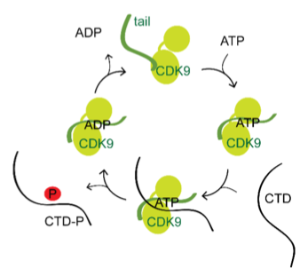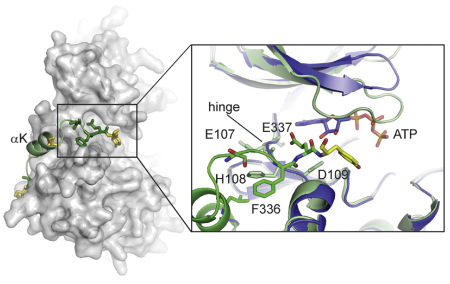CDK9
Transcription of protein-coding genes by RNA polymerase II (Pol II) is a highly regulated process. Pol II is recruited to gene promoters during transcription initiation and on many genes it subsequently pauses during early transcription elongation, providing an opportunity to recruit splicing factors, other transcription regulators and modify the RNA transcript. Promoter proximal pausing is reversed by the activity of P-TEFb, a complex of CDK9 and cyclin T1 or T2. P-TEFb phosphorylates key elongation factors as well as Ser2 within the heptad repeat sequence which constitutes the C-terminal domain of the largest Pol II subunit. These phosphorylation events release paused Pol II and allow productive transcription elongation. P-TEFb It is active within large macromolecular complexes that include BRD4, but can also be found in a mutually exclusive inhibitory complex that contains 7SK RNA, and the proteins HEXIM1 and LARP7. In addition to the conserved protein kinase domain, CDK9 has a characteristic C-terminal tail that is important for its activity.
Highlights of our study
-
Kinetic analysis shows that the CDK9 C-terminal tail sequence is important for the catalytic mechanism and imposes an ordered binding of substrates and release of products
-
Crystallographic analysis of a CDK9-cyclin T complex in which the C-terminal tail partially blocks the ATP binding site reveals a possible reaction intermediate
-
Biochemical characterization of CDK9 mutants supports a model in which the CDK9 tail cycles through different conformational states
-
We propose that this mechanism is critical for the pattern of RNA polymerase II C-terminal domain Ser2 phosphorylation on actively transcribed genes.


Collaborators: Colleagues at the NICR
Associated publications: The CDK9 Tail Determines the Reaction Pathway of Positive Transcription Elongation Factor b, (2012), Baumli et al., Structure 20: 1788-1795.
Crystal structure of full-length cdk9 in complex with cyclin t
PDB entries: 4EC9


